Dynabook UPA3233WL 802.11 a/b Combo Wireless LAN Module User Manual Manual
Toshiba Corporation 802.11 a/b Combo Wireless LAN Module Manual
Dynabook >
Contents
- 1. User Manual
- 2. PotegeM200 User Manual
- 3. Firebolt PA3233 Manual
User Manual
Atheros AR5001X Mini PCI Wireless Network AdapterAtheros AR5001X Mini PCI Wireless Network Adapter
Client Utility HelpClient Utility Help
IntroductionIntroduction..................................................................................................................................................... 2
Station ConfigurationStation Configuration .................................................................................................................................. 3
Add or Edit a Configuration ProfileAdd or Edit a Configuration Profile............................................................................................................. 3
General TabGeneral Tab .............................................................................................................................................. 4
Security TabSecurity Tab.............................................................................................................................................. 4
Advanced TabAdvanced Tab............................................................................................................................................ 5
Ad Hoc Mode Profile ConfigurationAd Hoc Mode Profile Configuration............................................................................................................. 5
Ad Hoc ModeAd Hoc Mode............................................................................................................................................. 6
Access Point Mode Profile ConfigurationAccess Point Mode Profile Configuration .................................................................................................... 6
Access Point ModeAccess Point Mode .................................................................................................................................... 7
Remove a Configuration ProfileRemove a Configuration Profile................................................................................................................... 7
TCP/IP ConfigurationTCP/IP Configuration .................................................................................................................................. 7
Station ConfigurationStation Configuration .................................................................................................................................. 7
Security TabSecurity Tab..................................................................................................................................................... 9
Define Static Encryption KeysDefine Static Encryption Keys..................................................................................................................... 9
Check the Status Information or StatisticsCheck the Status Information or Statistics ...................................................................................................11
Link StatuLink Statuss..................................................................................................................................................11
Advanced Link Status StatisticsAdvanced Link Status Statistics.............................................................................................................11
WLAN Status TabWLAN Status Tab.......................................................................................................................................12
Driver InfoDriver Informationrmation......................................................................................................................................13
StatisticsStatistics......................................................................................................................................................13
Site SurveySite Survey..................................................................................................................................................14
WLAN Status: Available APs andWLAN Status: Available APs and Ad Hoc Networks List Ad Hoc Networks List..............................................................................14
ToolsTools ................................................................................................................................................................16
Tray IconTray Icon......................................................................................................................................................16
Display SettingsDisplay Settings..............................................................................................................................................17
Information sheetInformation sheet ...........................................................................................................................................18

Introduction
The Atheros AR5001X Mini PCI Wireless Network Adapter are reference designs based on the Atheros
AR5001 chipsets. These reference designs support all IEEE 802.11a data rates (6 to 54 Mbps) and 802.11b
data rates (1 to 11 Mbps). In the Atheros Turbo ModeTM, they support data rates up to 108 Mbps.
The Atheros Client Utility (ACU) is a user-mode utility designed to display information and statistics
pertaining to a selected Atheros NIC, as well as to allow users to edit and add configuration profiles.

Station Configuration
Configure the Atheros AR5001X Mini PCI Wireless Network Adapter through the Atheros Client Utility.
The wireless network adapter (also called wireless card) works in either access point mode
(infrastructure mode - leverages an AP) or ad hoc mode (a group of stations participating in the WLAN).
To switch to another configuration profile, click on the profile name in the Select Profile list, then click the
Apply button.
l To add a configuration profile
l To edit a configuration profile
l Access Point (infrastructure) mode profile configuration
l Ad Hoc mode profile configuration
Add or Edit a Configuration Profile
1. To add a configuration profile, click New on the Station Configuration tab. To edit a
configuration profile, select the configuration from the list of profiles and click the
Modify button.
2. The Network Configuration Settings dialog box displays the General tab.
Edit the Network Configuration Settings:
l Edit the General tab.
l Edit the Security tab.
l Edit the Advanced tab.
To configure a profile for ad hoc or access point (infrastructure) mode, edit the Network Type field on the
General tab.

General Tab
In the Atheros Client Utility, access the General tab by clicking New or Modify on the Station
Configuration tab.
Edit the fields in the General tab to configure the configuration profile.
Make sure to also edit the Security and Advanced tabs.
Field Name Description
Configuration Name Identifies the configuration. This name
must be unique. Configuration names are
not case sensitive.
Network Name The IEEE 802.11a wireless network name,
for example, Atheros 802.11a Wireless
Network. This field has a maximum limit
of 32 characters.
Network Type Defines whether the station is configured
for an ad hoc or access point network.
Power Save Mode The power management options. Power
management is disabled in ad hoc mode.
OffOff
The adapter receives full power from the
PC.
NormalNormal
The driver turns off power to the adapter
for short periods over briefly spaced time
intervals.
MaximumMaximum
The driver turns off power to the adapter
for longer periods over more widely spaced
time intervals.
Security Tab
In the Atheros Client Utility, access the Security tab by clicking New or Modify on the Station
Configuration tab. Click the Security tab.
Edit the fields in the Security tab of the Network Configuration Settings to configure the profile.
Make sure to also edit the General and Advanced tabs.
Field Name Description
Encryption Type Specifies the encryption type:
Use Dynamic SecurityUse Dynamic Security
Use dynamic encryption keys, such as
those defined by Cisco LEAP or 802.1X.
To use Cisco LEAP, make sure the
checkbox "Enable Cisco LEAP" is checked,
and fill in the LEAP User Name and
Password.
Use Static KeysUse Static Keys
Use static encryption keys. Enter the keys
in the Encryption Keys fields.
DisabledDisabled
Use no encryption.
Enable Cisco LEAP Enables the use of Cisco LEAP for
dynamic security keys. Click the Use
Dynamic Security radio button under
Encryption Type to use Cisco LEAP.
User Name The user name used to log in to the
network.
Password
The password used to log in to the

network. This password is encrypted
using the same encryption type as the
encryption keys.
To define static encryption keys, click the Define Static Encryption Keys button with either Dynamic
Security or Static Keys selected. Fill in the security dialog box.
Advanced Tab
In the Atheros Client Utility, access the Advanced tab by clicking New or Modify on the Station
Configuration tab, then clicking the Advanced tab.
Edit the fields in the Advanced tab of the Network Configuration Settings to configure the configuration
profile.
Make sure to also edit the General and Security tabs.
Field Name Description
Wireless Address Wireless Address Specify the wireless card
address in hexadecimal (0-9, A-F).
Scan Mode Specify passive or auto scans. The scan
mode is set by the country code, with most
regions using an active scan mode.
Passive mode sets the wireless card to
listen-only mode. To override an active
setting, click passive.
802.11b Preamble
Specifies the preamble setting in 802.11b.
The default setting is Short & Long, which
allows both short and long headers in the
802.11b frames. Set to Long Only to
override allowing short frames.
Wireless Mode Specifies 5GHz 54 Mbps, 5 GHz 108 Mbps,
or 2.4 GHz 11 Mbps operation in an access
point network.
Wireless Mode when Starting
Ad Hoc Network Specifies 5GHz 54 Mbps, 5 GHz 108 Mbps,
2.4 GHz 11 Mbps to start an ad hoc
network if no matching network name is
found after scanning all available modes.
QoS Disables or enables the station to
cooperate in a network using Quality of
Service.
Transmit Power Level Selects full, half, quarter, eighth, or lowest
transmit power.
Ad Hoc Mode Profile Configuration
To configure a profile in ad hoc mode, change the Network Type in the General tab. This table provides the
General tab field descriptions to configure a profile for ad hoc mode:
Field Name Description
Configuration Name Identifies the configuration. This name
must be unique. Configuration names are
not case sensitive.
Network Name A network name is mandatory for ad hoc
mode. The SSID for all stations in a single
ad hoc network must be the same.
Network Type Ad hoc.
Power Save Mode Power saving mode is currently not
supported in ad hoc mode.
Make sure to also edit the Security and Advanced tabs.
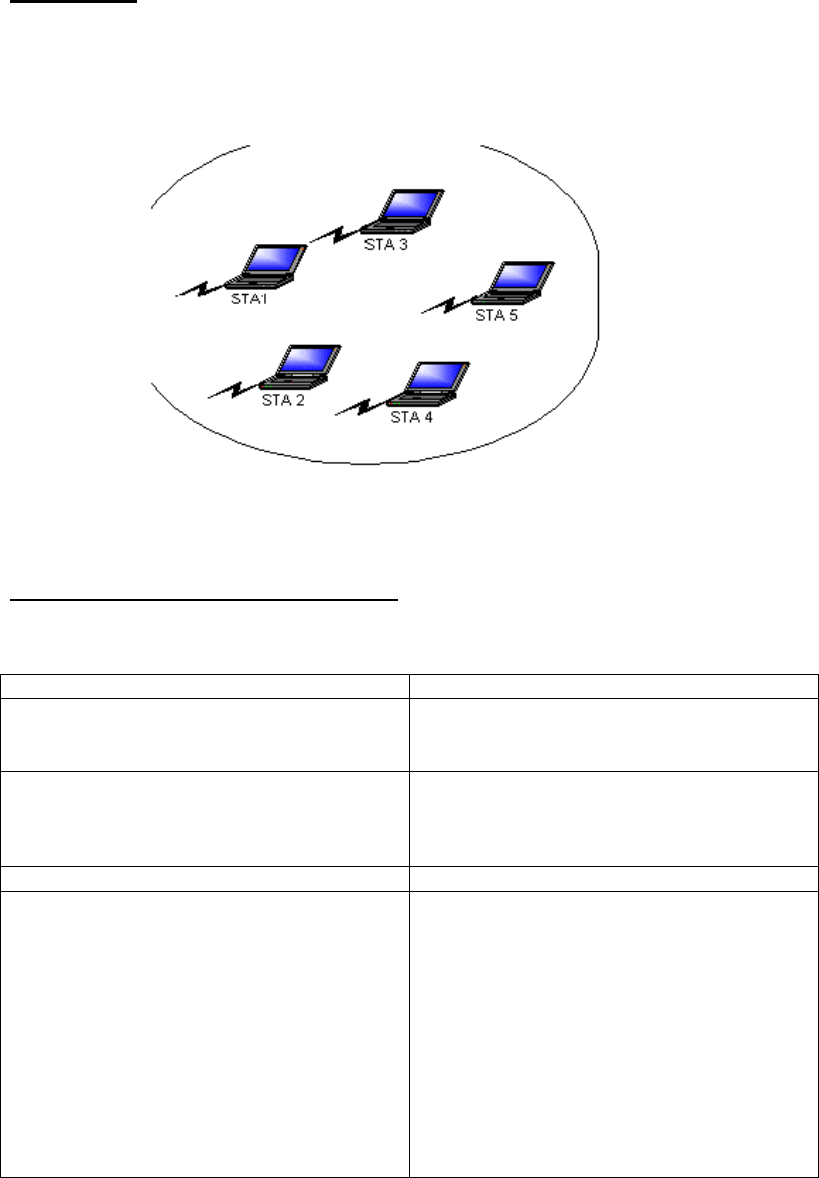
Ad Hoc Mode
In ad hoc mode, a Wireless Network Adapter works within an independent basic service set (IBSS), as
illustrated here. All stations communicate directly with other stations without an AP.
Ad Hoc ModeAd Hoc Mode
To connect to an ad hoc network, configure the profile for Ad Hoc mode.
Access Point Mode Profile Configuration
To configure a profile in Access Point (infrastructure) mode, change the Network Type in the General tab.
This table provides the General tab field descriptions to configure a profile for access point mode:
Field Name Description
Configuration Name Identifies the configuration. This name
must be unique. Configuration names are
not case sensitive.
Network Name The IEEE 802.11a wireless network name,
for example, Atheros 802.11a Wireless
Network. This field has a maximum limit
of 32 characters.
Network Type Access Point.
Power Save Mode The power management options.
OffOff
he adapter receives full power from the
PC.
Normal Normal
The driver turns off power to the adapter
for short periods over briefly spaced time
intervals.
Maximum Maximum
The driver turns off power to the adapter
for longer periods over more widely spaced
time intervals.
Make sure to also edit the Security and Advanced tabs.
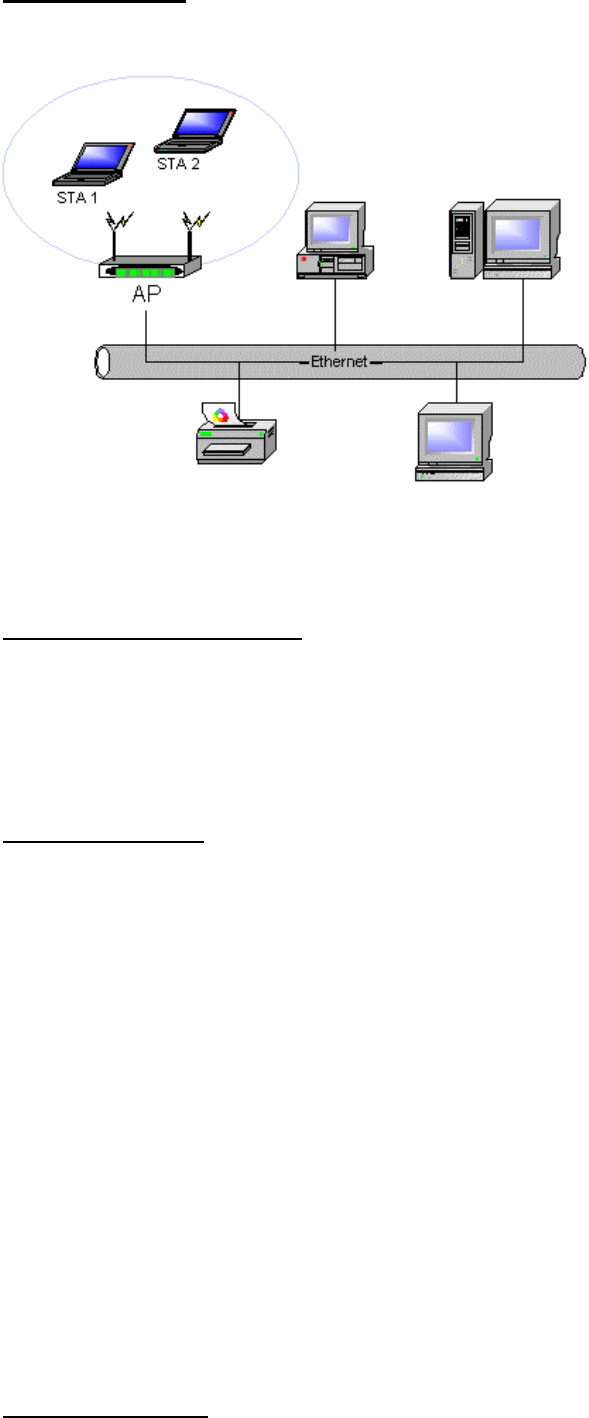
Access Point Mode
In Access Point (infrastructure) mode, the Wireless Network Adapter participates in a basic service set
(BSS) as a station, and communicates with the other stations through an AP, as illustrated here.
Access Point (Infrastructure) ModeAccess Point (Infrastructure) Mode
To connect to an Access Point network, configure the profile for Access Point mode.
Remove a Configuration Profile
1. To remove a configuration profile, select the profile to remove from the list of configuration profiles on
the Station Configuration tab.
2. Click the Remove button.
3. Click Apply to complete the configuration profile deletion.
TCP/IP Configuration
Configure the TCP/IP Address for the network device after configuring the Atheros AR5001X Mini PCI
Wireless Network Adapter properties.
1. Open the Control Panel and click Network and Dial-up Connections.
2. Find the Local Area Connection associated with the Atheros AR5001X Mini PCI Wireless Network
Adapter. Right-click that connection, and click Properties.
3. Select Internet Protocol (TCP/IP) and click Properties.
4. Click the radio button Use the following IP address, then enter an IP address and Subnet mask.
Assigning an IP address and Subnet mask allows stations to operate in Access Point mode
(infrastructure mode) and to have Internet access. Default gateway and DNS server information is
also required.
5. IP configuration information (DHCP or assigned IP address, gateway and DNS server IP addresses) is
usually obtained from the corporate IT staff.
6. Click OK to finish.
Station Configuration
Configure the Atheros AR5001X Mini PCI Wireless Network Adapter through the Atheros Client Utility.
The wireless network adapter (also called wireless card) works in either access point mode
(infrastructure mode - leverages an AP) or ad hoc mode (a group of stations participating in the WLAN).
To switch to another configuration profile, click on the profile name in the Select Profile list, then click the
Apply button.

Security Tab
In the Atheros Client Utility, access the Security tab by clicking New or Modify on the Station
Configuration tab. Click the Security tab.
Edit the fields in the Security tab of the Network Configuration Settings to configure the profile.
Make sure to also edit the General and Advanced tabs.
Field Name Description
Encryption Type Specifies the encryption type:
Use DynamicUse Dynamic Security Security
Use dynamic encryption keys, such as
those defined by Cisco LEAP or 802.1X.
To use Cisco LEAP, make sure the
checkbox "Enable Cisco LEAP" is checked,
and fill in the LEAP User Name and
Password.
Use Static Keys Use Static Keys
Use static encryption keys. Enter the keys
in the Encryption Keys fields.
DisabledDisabled
Use no encryption.
Enable Cisco LEAP Enables the use of Cisco LEAP for
dynamic security keys. Click the Use
Dynamic Security radio button under
Encryption Type to use Cisco LEAP.
User Name The user name used to log in to the
network.
Password The password used to log in to the
network. This password is encrypted
using the same encryption type as the
encryption keys.
To define static encryption keys, click the Define Static Encryption Keys button with either Dynamic
Security or Static Keys selected. Fill in the security dialog box.
Define Static Encryption Keys
To define static encryption keys, click the Define Static Encryption Keys button on the security tab.
Fill in the fields in the Security dialog box.
Field Name Description
Key Entry Method Determines the entry method for an
encryption key: hexadecimal (0-9, A-F), or
ASCII text (all keyboard characters).
Encryption Keys Selects the default encryption keys used
(either Unique or Shared). Only allows the
selection for a Unique key, or a shared
First, Second, Third, or Fourth key whose
corresponding field has been completed.
Unique Key Defines the unique encryption key for
network configuration security. This field
must be populated to enable security
using a unique key.
Click on the radio button to set the unique
key as the default encryption key.
Not used in ad hoc mode.
Shared Keys (First, Second, Third Fourth) Defines a set of shared encryption keys for
network configuration security. At least
one Shared Key field must be populated to
enable security using a shared key.
Click on the radio button to set the key as

the default encryption key.
Key Length Defines the length for each encryption key.
The options include:
64 bit (enter 10 digits)
128 bit (enter 26 digits)
152 bit (enter 32 digits)
As the Key Length is changed, the number
of available characters in the field
automatically changes. If an
already-entered key is too long, the key is
automatically truncated to fit. If the key
length is increased again, the field does
not update to its previous value.
Click OK for the changes to take effect.

Check the Status Information or Statistics
The Atheros client utility includes a number of tools to display current statistics and status information.
l Check link status
l Check WLAN status
l Check driver information
l Check receive and transmit statistics
l Check signal strength
Link Status
The Link Status tab of the Atheros Client Utility contains general information about the program and its
operations. The Link Status tab does not require any configuration.
The following table describes the items found on the Link Status screen.
Screen Item Description
Wireless Mode Displays the wireless mode. The options
include:
5 GHz 54 Mbps
5 GHz 108 Mbps
2.4 GHz 11 Mbps
Configure the wireless mode on the
Advanced tab.
Configuration Name The name of the current selected
configuration profile.
Set up the configuration name on the
General tab.
Link Status Shows whether the station is connected to
the wireless network.
Transmit Rate The transmit rate (Mbps) for the current
connection for the wireless driver.
Receive Rate The receive rate (Mbps) for the current
connection for the driver.
Network Type The type of network the station is
connected to. The options include:
Access Point (Infrastructure)
Ad Hoc
Configure the network type on the
General tab.
Security Mode Displays the security mode the driver is
using:
Off
WEP
AES-CCM
AES-OCB
Configure the security mode on the
Security tab. For more information, see
Encryption Types.
IP Address The IP address of the station.
Click the Advanced button to see the advanced link status statistics.
Advanced Link Status Statistics
Click the Advanced button on the Link Status tab of the Atheros Client Utility to see advanced
information about the program and its operations. The Link Status tab does not require any configuration.

The following table describes the items found on the Advanced Link Status screen.
Screen Item Description
Country
The regulatory domain of the network.
The options include:
FCC
MKK
ETSI
Configure the country in the country code
selector, accessible from the Tools tab.
Transmit Power Level The transmit power level:
Full (100%)
Half (50%)
Quarter (25%)
Eighth (12.5%)
Lowest
Configure the transmit power level on the
Advanced tab.
Network Name (SSID) The wireless network name.
Configure the network name on the
General tab.
QoS Shows whether the station is enabled to
cooperate in a network using Quality of
Service.
Configure QoS on the Advanced tab.
Noise Level The amount of noise (dBm) in the current
connection.
Power Save Mode The power management options. Power
management is disabled in ad hoc mode.
OffOff
The adapter receives full power from the
PC.
NormalNormal
The driver turns off power to the adapter
for brief periods over briefly-spaced time
intervals.
MaximumMaximum
The driver turns off power to the adapter
for longer periods over more widely spaced
time intervals.
Configure the power save mode on the
General tab.
Channel/Frequency The channel and frequency the station is
using.
WLAN Status Tab
The WLAN status tab of the Atheros Client Utility contains information about the basic service set (BSS).
The WLAN Status tab does not require any configuration.
The following table describes the items found on the WLAN Status screen.
Screen Item Description
Network Name (SSID) The network name of the selected wireless
LAN.
Configure the network name on the
General tab.
AP Address (BSSID)
The MAC address of the connected Access

Point (basic service set identification).
Station Status The operational status of the wireless
card:
AssociatedAssociated
The station is associated to the network.
AuthenticatedAuthenticated
The station has been authenticated by the
access point.
DisassociatedDisassociated
The station is not associated to the
network.
Channel/Frequency The channel and frequency the station is
using.
The WLAN Status screen also includes the Available APs and Ad Hoc Networks list, which describes the
available APs and ad hoc networks.
Double-click on a network name to connect an available network. If no configuration profile exists for that
network, double-click on the network name to create a configuration profile for that network.
Driver Information
The Driver Information tab of the Atheros Client Utility contains general information about the network
interface card (the wireless card) and the network driver interface specification (NDIS) driver. The
Driver Information tab does not require any configuration.
The following table describes the items found on the Driver Information screen.
Screen Item Description
Card Name The name of the wireless card.
MAC Address The MAC address of the wireless card.
Driver The driver name and path of the wireless
card driver.
Driver Version The version of the wireless card driver.
Driver Date The creation date of the wireless card
driver.
Statistics
The Statistics tab of the Atheros Client Utility contains receive and transmit statistics. The Link Status
tab does not require any configuration.
The Statistics tab lists uptime as well as the following receive and transmit statistics for frames received
by or transmitted by the wireless card:
Multicast frames transmitted and received
Broadcast frames transmitted and received
Unicast frames transmitted and received
Total bytes transmitted and received
Click the Advanced button to also show receive and transmit statistical information for the following
receive and transmit statistics for frames received by or transmitted to the wireless card:
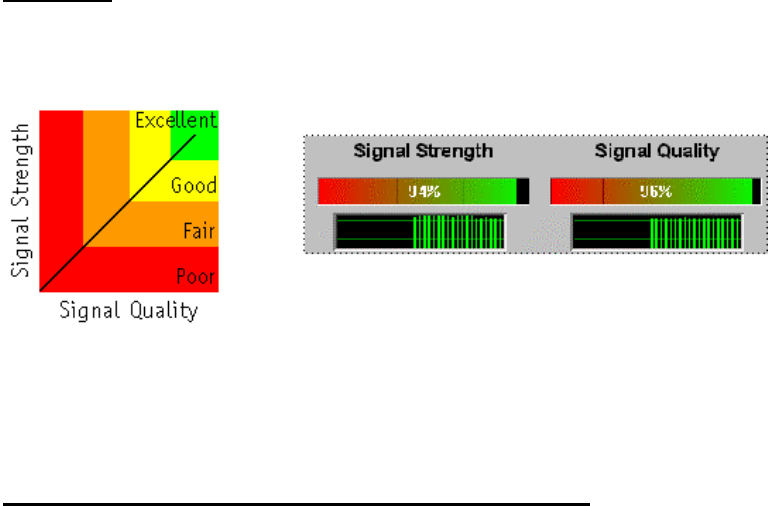
Beacons transmitted and received
Frames transmitted and received OK
Transmitted frame retried
Frames dropped
RTS frames sent
Frames received with errors
Encryption errors
Duplicate frames received
CTS frames received
Authentication rejects
Association rejects
Click the Reset button to reset the statistics.
Site Survey
The Site Survey tool displays the quality and strength of the signal. On the left, the tool graphs signal
strength and quality. On the right side, signal strength and signal quality are indicated separately in a bar
graph and histogram. All graphs also use color to indicate signal quality.
Site Survey ToolSite Survey Tool
Identify the need of additional access points in the network using these measurements while changing the
location of the wireless card.
WLAN Status: Available APs and Ad Hoc Networks List
The WLAN status tab of the Atheros Client Utility contains information about the available access point
and ad hoc networks. The Available Access Points (APs) and Ad Hoc Networks list describes the available
APs and ad hoc networks.
Double-click on a network name to connect an available network. If no configuration profile exists for that
network, double-click on the network name to create a configuration profile for that network.

The following table describes the columns found in the Available APs and Ad Hoc Networks list.
Column Item Description
Network Name (SSID) The IEEE 802.11a wireless network name
(service set identification).
Configure the network name on the
General tab.
Signal Strength The received signal strength indicator.
Displays the signal strength in either
dBm or %, as well as displaying the signal
strength indicator.
Mode Displays the wireless mode. The options
include:
A 5.4 GHz 54 Mbps
T 5.4 GHz 108 Mbps
B 2.4 GHz 11 Mbps
Configure the wireless mode on the
Advanced tab.
Channel The channel the station is using.
Frequency The frequency the station is using.
AP Address (BSSID) The network AP address (basic service set
identification).
To connect to another network:To connect to another network:
Double-click on the network name in the list of Available APs and Ad Hoc Networks.
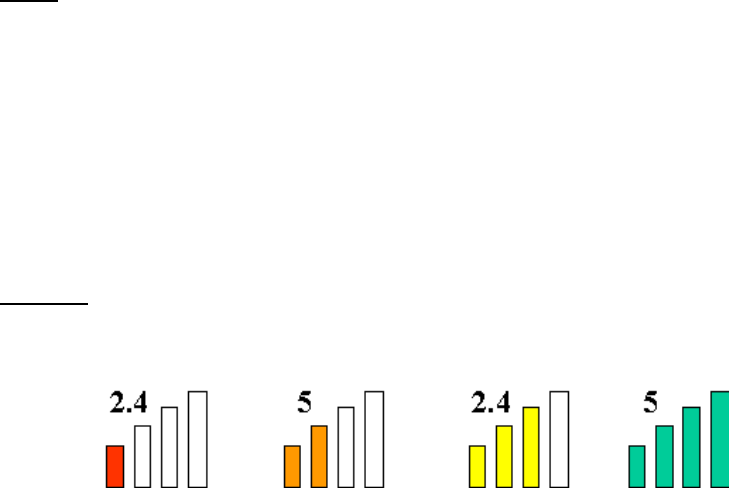
Tools
The Tools tab contains the following tools:
Radio Enable/Disable Enable or disable the RF Signal on all Atheros Station Reference
Designs.
Site Survey Open the Site Survey tool to view the signal quality and strength.
Tray Icon Enable/Disable Enable or disable the tray icon.
Tray Icon
The tray icon appears at the bottom of the screen, and shows the signal strength using colors and the
received signal strength indication (RSSI).
Tray IconsTray Icons
Hold the mouse cursor over the tray icon to display transmit and receive speed and the current
configuration profile name.
Right-click on the tray icon to:
Launch Station Utility Launch the Atheros Client Utility. Use the Atheros Client Utility to
configure the profile or view status and statistics information.
Display available configuration profiles
Display a list of available configurations.
Switch to another configuration profile
Click a configuration profile name to switch to it. If no configuration
profile exists for a connection, add a profile first.
Enable/disable radio Enable or disable the RF Signal.
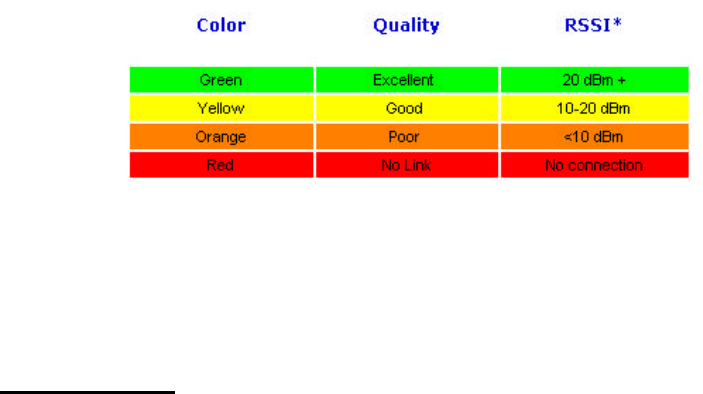
Open the Country Code Selector Open the Country Code Selector to set the regulatory domain of the
configuration profile.
Open the Site Survey tool Open the Site Survey tool to view the signal quality and strength.
The colors are defined as follows:
*Received signal strength indication RSSI.
Displayed in decibels relative to one milliwatt (dBm) or percentage.
Enable or disable the tray icon in the Action menu.
Display Settings
To change the display settings, choose Options > Settings from the menu.
The display settings dialog box contains tools to set the:
Signal Strength Display Units Sets the units used when displaying signal strength: percentage or
decibels relative to one milliwatt (dBm).
Data Display Sets the display to cumulative or relative.
Cumulative displays statistical data collected from the beginning of
driver load.
Relative displays the change (delta) in statistical data since the last
update.
Refresh Interval Sets the display refresh interval in milliseconds (ms).

Information sheet
Wireless Interoperability
The Atheros AR5001X Mini PCI Wireless Network Adapter products are designed to be interoperable with any
wireless LAN product that is based on Direct Sequence Spread Spectrum (DSSS) radio technology, and is
compliant to:
The IEEE 802.11 Standard on Wireless LANs(Revision A/B), as defined and approved by the Institute
of Electrical and Electronics Engineers.
The Wireless Fidelity(WiFi) certification as defined by the WECA Wireless The Wireless Fidelity(WiFi) certification as defined by the WECA Wireless
Ethernet Compatibility Alliance.Ethernet Compatibility Alliance.
CAUTION
Bluetooth™ and WirelessLAN devices operate within the same radio frequency range and may interfere
with one another. If you use Bluetooth™ and WirelessLAN devices simultaneously, you may occasionally
experience a less than optimal network performance or even lose your network connection.
If you should experience any such problem, immediately turn off either one of your Bluetooth™ or
WirelessLAN.
Please contact Toshiba PC product support on web site
http://www.toshiba-europe.com/computers/tnt/bluetooth.htm in Europe or
http://www.pc.support.global.toshiba.com in the United States for more information.
CAUTION
This device is restricted to indoor use due to its operation in the 5.15 to 5.85 GHz frequency range.
Wireless LAN and your Health
Wireless LAN products, like other radio devices, emit radio frequency electromagnetic energy. The level of
energy emitted by Wireless LAN devices however is far much less than the electromagnetic energy emitted
by wireless devices like for example mobile phones.
Because Wireless LAN products operate within the guidelines found in radio frequency safety standards
and recommendations, TOSHIBA believes Wireless LAN is safe for use by consumers. These standards and
recommendations reflect the consensus of the scientific community and result from deliberations of panels
and committees of scientists who continually review and interpret the extensive research literature.
In some situations or environments, the use of Wireless LAN may be restricted by the proprietor of the
building or responsible representatives of the organization. These situations may for example include:
Using the Wireless LAN equipment on board of airplanes, or
In any other environment where the risk of interference to other devices or services is perceived or
identified as harmful.
If you are uncertain of the policy that applies on the use of wireless devices in a specific organization or
environment (e.g. airports), you are encouraged to ask for authorization to use the Wireless LAN device
prior to turning on the equipment.
Regulatory Information
The Atheros AR5001X Mini PCI Wireless Network Adapter must be installed and used in strict
accordance with the manufacturer’s instructions as described in the user documentation that comes with
the product. This device complies with the following radio frequency and safety standards.
Canada – Industry Canada (IC)
This device complies with RSS 210 of Industry Canada.
Operation is subject to the following two conditions: (1) this device may not cause interference, and (2) this
device must accept any interference, including interference that may cause undesired operation of this
device.”
L ‘ utilisation de ce dispositif est autorisée seulement aux conditions suivantes : (1) il ne doit pas produire
de brouillage et (2) l’ utilisateur du dispositif doit étre prêt à accepter tout brouillage radioélectrique reçu,
même si ce brouillage est susceptible de compromettre le fonctionnement du dispositif.
The term "IC" before the equipment certification number only signifies that the Industry Canada technical
specifications were met.
IC : 248H-DPA3233W
This device has been designed to operate with an antenna having a maximum gain of 4.8dB.
Antenna having a higher gain is strictly prohibited per regulations of Industry Canada. The required
antenna impedance is 50 ohms.
To reduce potential radio interference to other users, the antenna type and its gain should be so chosen
that the equivalent isotropically radiated power (EIRP) is not more than that required for successful
communication.
To prevent radio interference to the licensed service, this device is intended to be operated indoors and
away from windows to provide maximum shielding. Equipment (or its transmit antenna) that is installed
outdoors is subject to licensing.
Pour empecher que cet appareil cause du brouillage au service faisant l'objet d'une licence, il doit etre
utilize a l'interieur et devrait etre place loin des fenetres afin de Fournier un ecram de blindage maximal.
Si le matriel (ou son antenne d'emission) est installe a l'exterieur, il doit faire l'objet d'une licence.

Europe – EU Declaration of Conformity
This device complies with the essential requirements of the R&TTE Directive 1999/5/EC with essential
test suites as per standards:
EN 60950 Safety of Information Technology equipment
ETS 300 328 Technical requirements for radio equipment
ETS 300 826 General EMC requirements for radio equipment.
For outdoor usage only channel 10 (2457 MHz) and 11 (2462 MHz) is allowed.
For private usage outside buildings across public grounds over less than 300m no special registration with IBPT/BIPT is
required. Registration to IBPT/BIPT is required for private usage outside buildings across public grounds over more than
300m. An IBPT/BIPT license is required for public usage outside building.
For registration and license please contact IBPT/BIPT.
Gebruik buiten gebouw alleen op kanalen 10 (2457 MHz) en 11 (2462 MHz). Voor privé-gebruik buiten gebouw over
publieke groud over afstand kleiner dan 300m geen registratie bij BIPT/IBPT nodig; voor gebruik over afstand groter dan
300m is wel registratie bij BIPT/IBPT nodig. Voor publiek gebruik buiten gebouwen is licentie van BIPT/IBPT verplicht.
Voor registratie of licentie kunt u contact opnemen met BIPT.
België/
Belgique:
L’utilisation en extérieur est autorisé sur le canal 10 (2457 MHz) et 11 (2462 MHz).
Dans le cas d’une utilisation privée, à l’extérieur d’un bâtiment, au-dessus d’un espace public, aucun enregistrement n’est
nécessaire pour une distance de moins de 300m. Pour une distance supérieure à 300m un enregistrement auprès de
I’IBPT est requise. Pour une utilisation publique à I’extérieur de bâtiments, une licence de I’IBPT est requise. Pour les
enregistrements et licences, veuillez contacter I’IBPT.
License required for outdoor installations. Check with reseller for procedure to follow Deutschland: Anmeldung im Outdoor-Bereich notwendig, aber nicht genehmigungspflichtig.Bitte mit Händler die Vorgehensweise
abstimmen.
Restricted frequency band: only channels 10 and 11 (2457 MHz and 2462 MHz respectively) may be used in France.
License required for every installation, indoor and outdoor installations. Please contact ART for procedure to follow.
France:
Bande de fréquence restreinte : seuls les canaux 10 à 11 (2457 et 2462 MHz respectivement) doivent être utilisés en
France.
Toute utilisation, qu’elle soit intérieure ou extérieure, est soumise à autorisation. Vous pouvez contacter I’Autorité de
Régulation des Télécommuniations (http://www.art-telecom.fr) pour la procédure à suivre.
License required for indoor use. Use with outdoor installations not allowed Italia: E’necessaria la concessione ministeriale anche per l’uso interno.
Verificare con i rivenditori la procedura da seguire. L’uso per installazione in esterni non e’ permessa.
License required for outdoor installations. Check with reseller for procedure to follow Nederland Licentie verplicht voor gebruik met buitenantennes. Neem contact op met verkoper voor juiste procedure
USA-Federal Communications Commission (FCC)
This device complies with Part 15 of FCC Rules. Operation of the devices in a Wireless LAN System is
subject to the following two conditions:
This device may not cause harmful interference.
This device must accept any interference that may cause undesired operation.
TOSHIBA is not responsible for any radio or television interference caused by unauthorized modification of the
devices included with this Atheros AR5001X Mini PCI Wireless Network Adapter , or the substitution or
attachment of connecting cables and equipment other than specified by TOSHIBA.
The correction of interference caused by such unauthorized modification, substitution or attachment will be the
responsibility of the user.
Caution: Exposure to Radio Frequency Radiation.
The Atheros AR5001X Mini PCI Wireless Network Adapter will be installed with one of two types of
antennas. The both of antenna types, when installed are located at the upper edge of the LCD screen.
For both antennas, the radiated output power of the Atheros AR5001X Mini PCI Wireless Network Adapter
is far below the FCC radio frequency exposure limits. Nevertheless, the Atheros AR5001X Mini PCI Wireless
Network Adapter shall be used in such a manner that the potential for human contact during normal
operation is minimized. In normal operating configuration, the LCD in the upright position, the distance
between the antenna and the user should not be less than 20cm. The antenna(s) used for this transmitter
must not be co-located or operating in conjunction with any other antenna or transmitter. Antenna(s) used in
5.15-5.25GHz frequency band must be integral antenna which provide no access to the end user.
Refer to the Regulatory Statements as identified in the documentation that comes with those products
for additional information.
Relevant transmitters include FCC IDs: CJ6UPA3233WL, CJ6UPA3232BT.
The installer of this radio equipment must ensure that the antenna is located or pointed such that it
does not emit RF field in excess of Health Canada limits for the general population; consult Safety
Code 6, obtainable from Health Canadas website www.hc-sc.gc.ca/rpb.
Caution: Radio Frequency Interference Requirements.
This device is restricted to indoor use due to its operation in the 5.15 to 5.25 GHz frequency range. FCC
requires this product to be used indoors for frequency range 5.15 to 5.25 GHz to reduce the potential for
harmful interference to co-channel Mobile Satellite systems.
High power radars are allocated as primary users of the 5.25 to 5.35 GHz and 5.65 to 5.85 GHz bands. These
radar stations can cause interference with and/or damage this device.
Taiwan
Article 14 Unless approved, for any model accredited low power radio frequency electric machinery, any
company, trader or user shall not change the frequency, increase the power or change the
features and functions of the original design.
Article 17 Any use of low power radio frequency electric machinery shall not affect the aviation safety
and interfere with legal communications. In event that any interference is found, the use of
such electric machinery shall be stopped immediately, and reusing of such products can be
resumed until no interference occurs after improvement.
The legal communications mentioned in the above item refer to radio communications
operated in accordance with telecommunication laws and regulations.
Low power radio frequency electric machinery shall resist against interference from legal
communications or from industrial, scientific and medical radio emission electric machinery.
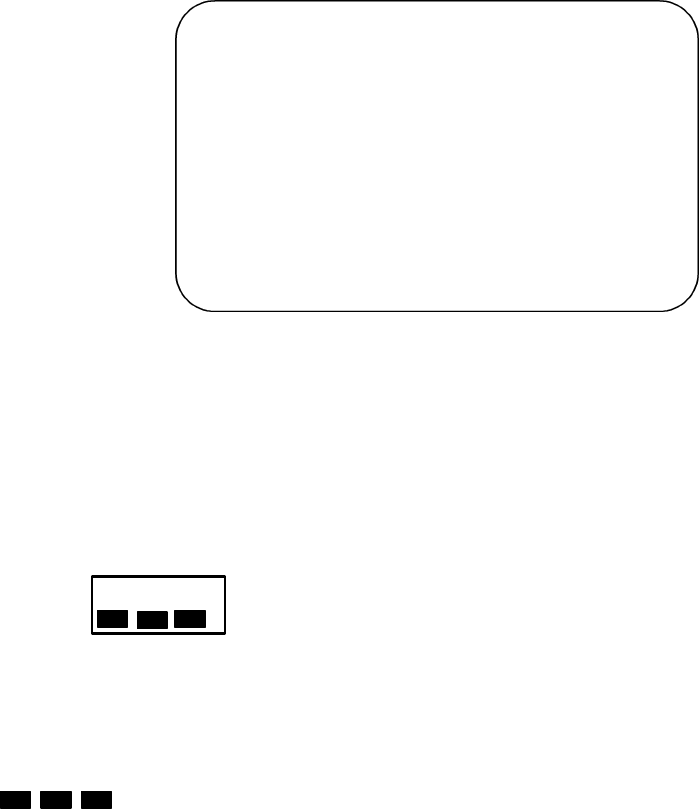
Using this equipment in Japan
In Japan, the frequency bandwidth of 2,400 2,483.5MHz for second generation low-power data
communication systems such as this equipment overlaps that of mobile object identification systems
(premises radio station and specified low-power radio station).
1. Sticker
Please put the following sticker on devices incorporating this product.
2. Indication
The indication shown below appears on this equipment.
(1) 2.4this equipment uses a frequency of 2.4GHz.
(2) DSThis equipment uses DS-SS modulation.
(3) 4The interference range of this equipment is less than 40m.
(4) This equipment uses a frequency bandwidth from 2,400MHz to 2,483.5MHz.
It is possible to avoid the band of mobile object identification systems.
3. TOSHIBA Direct PC
Monday – Friday : 10:00 – 17:00
Toll Free Tel : 0120-13-1100
Direct Dial : 03-3457-5916
Fax : 03-5444-9450
2.4DS4
(1) (2) (3)
(4)
In the frequency bandwidth of this equipment, industrial device,
scientific device, medical de
vice like microwave oven, licensed
premises radio station and non-licensed specified low-
power radio
station for mobile object identification system (RF-
ID) that is used in
product line of factories,(Other Radio Stations)are used.
1 Please make sure before
using this equipment that no Other Radio
Stations are used in the neighborhood.
2 In case that RF interference occurs to Other Radio Stations from this
equipment, please change promptly the frequency for use, place to
use, or stop emitting Radio.
3 Please contact TOSHIBA Direct PC
if you have a problem, such as
interference from this equipment to Other Radio Stations
Device Authorization
This device obtains the Technical Regulation Conformity Certification and the Technical Conditions
Compliance Approval, and it belongs to the device class of radio equipment of low-power data
communication system radio station stipulated in the Radio Law and the Telecommunications Business
Law of Japan.
The Name of the radio equipment: PA3232U-1MPC
TELECOM ENGINEERING CENTER Approval Number: 03NYA0018, 03GZDA0017
The following restrictions apply:
Do not disassemble or modify the device.
Do not install the embedded wireless module into other device.
Trademark
Bluetooth is a trademark owned by its proprietor and used by TOSHIBA under license.